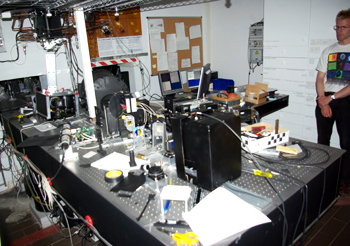
Two of the fourteen telescopes at the Roque de los Muchachos observatory are solar telescopes — highly specialised to observe our own sun. This is the Swedish Solar Telescope, which was the first telescope built on the Roque. It’s currently the best solar telescope in the world since they added the new adaptive optics in 2005. (Adaptive optics compensate for air turbulence.) It can resolve details of the sun’s surface only 70km across.
Whereas most telescopes struggle to collect enough light, the main design problem for solar telescopes is air turbulence caused by heat. They solved this by making most of the tower a vacuum tube. Of course that means that the 1 metre lens at the top of the tower has to be very strong to cope with the pressure difference, as well as optically perfect.
The rounded thingamybob on the top of the tower behind the man is called a heliostat: it follows the sun across the sky and sends the image down the tower to the instruments in the basement.
And here is the basement. At the top left you can see the bottom of circle where the sunlight comes down, together with some of the copper water pipes for cooling it. The light is then split up: some goes to the adaptive optics and most to a series of cameras, each of which observes a different wavelength.

They observe things like sunspots, which are areas of the sun’s surface where an intense magnetic field interferes with convection, and keeps the temperature to a mere 4000 ºC, instead of 5800 ºC like the rest. Each spot may be several times the size of the Earth.
If you want more details, the telescope’s home page is here, and there’s a chapter on it in “A Breathtaking Window on the Universe: A guide to the observatory at the Roque de los Muchachos“.
